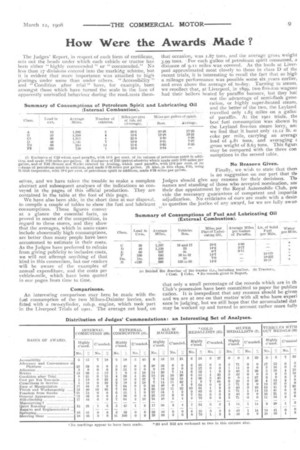How Were the Awards Made ?
Page 11

If you've noticed an error in this article please click here to report it so we can fix it.
The Judges' Report, in respect of each form of certificate, sets out the heads under which each vehicle or tractor has been either "highly commended " or " commended." No less than 17 divisions entered into the marking scheme, but it is evident that more importance was attached to high placings under some than under others. "Accessibility "and "Condition after trial " have, for example, been amongst those which have turned the scale in the face of apparently unrivalled behaviour during the road. tests them abstract and subsequent analyses of the indications so conveyed in the pages of this official production. They are to compile a couple of tables to show the fuel and lubricant selves, and we have taken the trouble to make a complete contained in the table at the foot of this page. We have also been able, in the short time at our disposal, consumptions. These figures convey at a glance the essential facts, as proved in course of the competition, in regard to these stores, and they show
that the averages, which in some cases Class. rat in include abnormally high consumptions, are better than many people have been ---1— accustomed to estimate in their costs.
As the Judges have preferred to refrain C from giving publicity to inclusive costs, 30
40 60
we will not aftempt anything of that 100 kind in this connection, but our readers Do. DO,
(4120
will be aware of the examples of
annual expenditure, and the costs per (a) Behind vehicle-mile, which have been quoted in our pages from time to time.
Comparisons.
An interesting comparison may here be made with the fuel consumption of the two Milnes-Daimler lorries, each fitted with a two-cylinder, ioh.p, engine, which took part in the T.iverpool Trials of 1901. The average net load, on
that occasion, was 1.87 tons, and the average gross weight 3.99 tons. For each gallon of petroleum spirit consumed, a distance of 9.11 miles was covered. As the loads at Liver. pool approximated most closely to those in class D of the recent trials, it is interesting to recall the fact that so high a mileage performance was possible some six :years earlier, and even above the average of to-day. Turning to steam, we recollect that, at Liverpool, in 1899, two five-ton wag-ons. had their boilers heated by paraffin burners, but they haC not the advantage of serni-flash gene. ration, or highly super-heated steam, and the better of the two, the Leyland travelled only 1.85 .miles on a gallor of paraffin. At the 19oi trials, the best fuel consumption was shown the Leyland five-ton steam lorry, ant we find that it burnt only 12.12 lb. o. coke per mile, carrying an averagt load of 4.81 tons, and averaging gross weight of 8.63 tons. This figure may be compared with the three con surnptions in the second table.
Miles per gallon of spirit. Best. Average.
22-25 17•92 1629 13'22
9-88 8-98
9-91 717 9.05 6-26
3-94 No Reasons Given.
Finally, we wish to state that there
is no suggestion on our part that the Judges should give any reasons for their decisions. Th4 names and standing of those who accepted nomination, am their due appointment by the Royal Automobile Club, pro vide the necessary guarantees of competent and impartia adjudication. No criticisms of ours are made with a desin to question the justice of any award, for we are fully aware
that only a small percentage of the records which are in th Club's possession have been committed to paper for publica cation. It is inexpedient that any reasons should be given and we are at one on that matter with all who have experi ence in judging, but we still hope that the accumulated dat. may be worked up and turned to account rather more fully


























